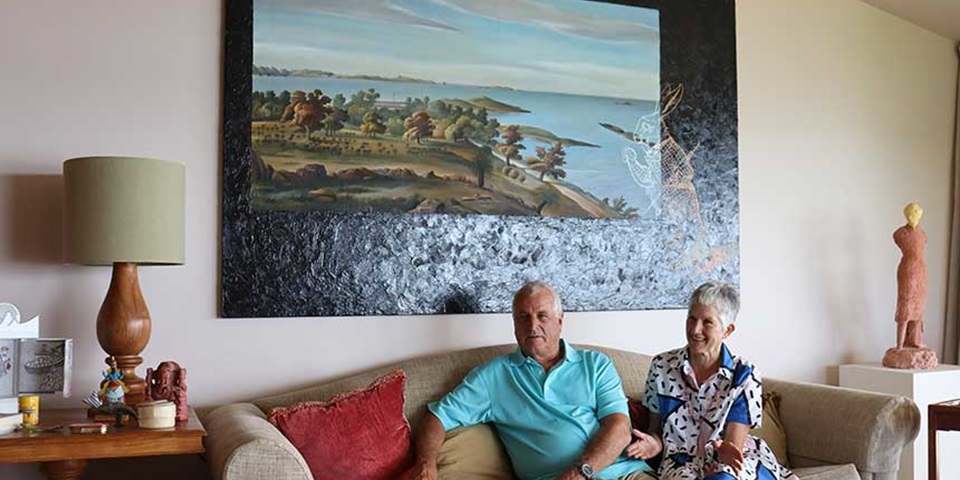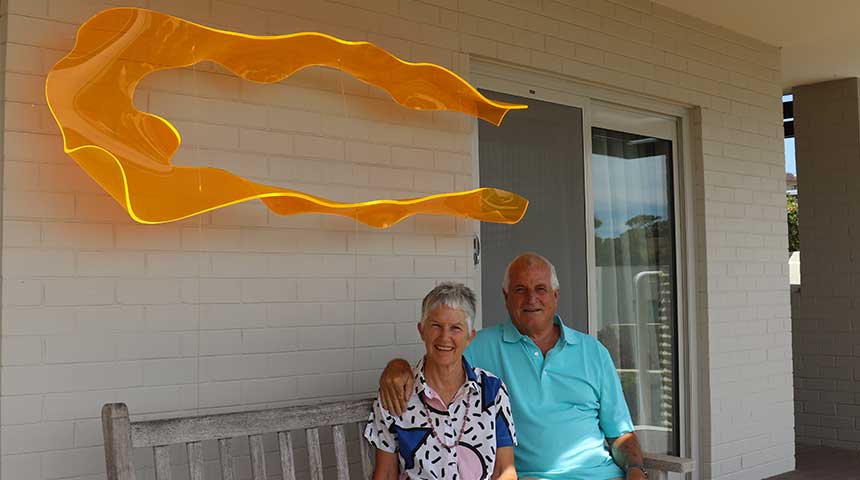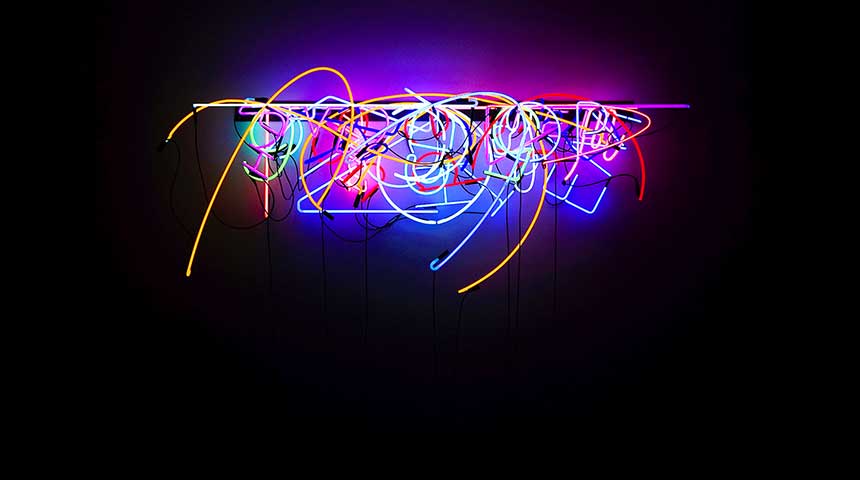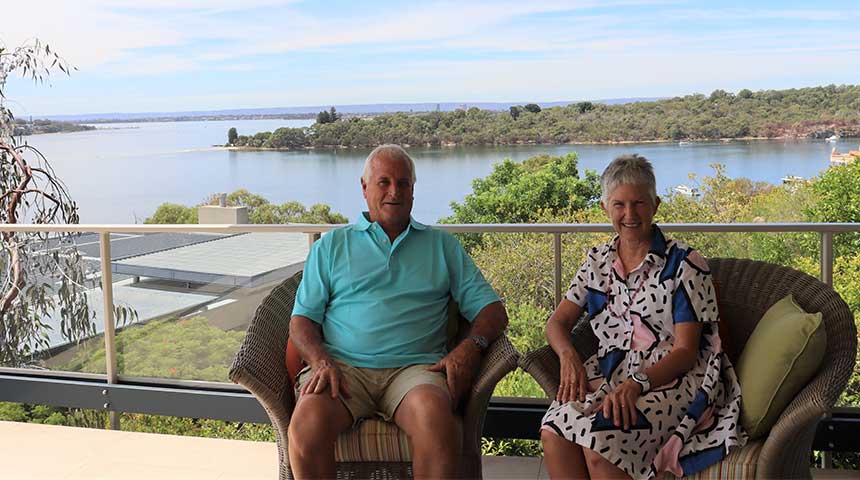Blog
Home is where the art is

Jenny and Wyborn Seabrook are passionate collectors.
The recent donation of nine major artworks to the Murdoch University Art Collection was a significant chapter in the art collecting story of Wyborn and Jenny Seabrook. Over nearly 25 years, the art donors have built an impressive collection at their Mosman Park residence and deepened their established love for art.
For Jenny, this passion had its foundations in early childhood, when her Mum would take her and her sisters to visit Perth galleries such as Rose Skinner’s in Mount Street, throughout the late 1960s.
Jenny built a formidable career in accountancy and executive management and by the mid-1990s was in a position to be able to begin building an art collection. Before embarking on this journey, she was keen to consult with people who knew the landscape. For this, Jenny was able to draw on her personal network. She went to school with Susan Cruthers, daughter of well known art collectors and philanthropists Sheila and Jim Cruthers, and sister to John Cruthers. Now one of Australia’s most respected art advisers, it was John who became her first guide.
“With my family background in business, I wasn’t interested in just buying anything. I wanted to find someone who knew about art to help me make informed decisions. For me, you have an adviser to advise you on investing, so why wouldn’t you have an adviser to advise you on art. Plus, if you want to do something, why not do it well, rather than in a half-hearted fashion?” said Jenny.
She began the collection with the acquisition of Indigenous works. A trip to the Northern Territory saw her acquire Flying Fox Dreaming (1984) by George Milpurrurru, an artist who painted the birds and animals of Arafura swamp on bark. This first work still greets visitors as a centrepiece of her current entrance hallway.
“I was also drawn to the early Indigenous works because I had grown up in the northwest of WA. As well as being collectable, they reminded me of the corroborees we used to have as young kids - something that was very dear to me.”
Jenny’s next acquisition was a work by two-time Wynne Prize winner, Robert Juniper, famous for his evocative depictions of the WA landscape.
“The work is called Tides Out, Broome (1994) and depicts the retreating ocean. I bought it from Robert’s studio in Darlington as part of a fundraiser for the Royal Flying Doctor Service (RFDS). My mum was a big fundraiser for the RFDS, and I was happy to contribute through this work which was quite contemporary for its time,” said Jenny.
Cranes and Waterlilies (1994) by William Boissevain was the next addition to the collection, followed by a large painting titled The Nine Muses (1996) by Tasmanian artist David Keeling. The latter work depicts nine people singing a song just after the Port Davey massacre and was included in a major survey exhibition of Keeling’s artworks titled ‘Stranger’ at the Tasmanian Museum & Art Gallery in late 2020.
In the late 1990s, Jenny met her husband, Wyborn Seabrook, a professional sailor who has competed in numerous, prestigious international sailing events. Sharing Jenny’s passion for art, the couple have subsequently built an enviable private collection over the last two decades.
In their early years together, John Cruthers suggested they expand their research and immerse themselves in auction and art catalogues. The Seabrooks' diligence and increasing knowledge soon brought dividends and saw them acquire some exceptional artworks.
For example, they bought some overlooked work by Clarice Beckett, a key figure in the Australian tonalist movement that developed in Victoria in the 1910s. One work, Brighton Jetty (1931), Wyborn was particularly keen to acquire as it echoed his strong connection to the water. Another Beckett work, Zinnias (1922), came up for auction in 1998, but surprisingly attracted minimal interest and Jenny was able to add it to their collection. The work gradually garnered wider acclaim, eventually featuring on numerous postcards and hung as part of The Present Moment, a Beckett retrospective at the Art Gallery of South Australia last year.
Collecting as a couple has been relatively smooth process with Jenny and Wyborn rarely struggling to agree on a purchase.
“Our taste is fairly aligned. We have discussions sometimes. When Jen gets excited about something I normally say that I can live with it, or I can’t. But most of the time we agree and can find common ground quite easily,” said Wyborn.
“We used to go through the art catalogues and ask each other, Which ones do you like? On the occasions where you had nothing in common, you would go back and have a look at what the other person was interested in and hence gradually develop an understanding of the work they like,” added Jenny.


When pressed on ‘how’ work ultimately makes its way into their collection, Jenny explained that there were a few different ways.
“Some things you don’t buy instantly. They work away at you, they are emotional. They move you to a certain extent and never leave the back of your mind. A neon artwork titled Colour Composition # 3 (2013) by Brendan Van Hek had that particular journey with us. We have had several instances like that, sometimes even where we originally missed out, but by circumstance it became available again years later. For other work, we can be spontaneous and maybe buy on the day we go to an exhibition.”
“When you are into collecting art, you see art everywhere, you see it in different settings, and it appeals to you in different ways. We are not just into contemporary art, it’s whatever creates a theme, or a feeling to you that’s meaningful or memorable, and art that is worthwhile having. Because having things takes space, it’s a load, that you are taking on, and you have a responsibility. So, when you have a responsibility, you look at why you want to take it on. It sounds a serious way of looking at it, but it is a responsibility. Collecting things that you enjoy, that you can share, pass on to someone else, or perhaps donate.”
“It’s a kind of custodianship,” added Wyborn. “You are the transient owner of a piece of work that will continue on after you.”
Wyborn reiterated the simple joy and pleasure that also underpins being a collector.
“We don’t buy because it’s collectable, we buy because we love it. You have to live with the work and want to live with it and enjoy it. That’s the prime motivation to purchase. We have bought a lot of very cheap work that has no commercial value, but we love them. Then you have quirky works that we love, or perhaps suit a space perfectly. And yes, sometimes the elements merge whereby we love it, it’s collectable and it perfectly suits the space.”
Expansion of their collection accelerated with the acquisition of Kiwi Fruit (1993) by celebrated Brisbane artist Robert MacPherson. Ada Bird Petyarre’s Emu Tracks, Waterhole (1999) was next, which now adorns a wall of their holiday home in the Southwest. This was followed by Abdul Abdullah’s Fuck Off We’re Full (2013), AB Webb’s Landscape (1925) and Bayon Head (1969), a work by Guy Grey-Smith, often described as ‘one of Australia's most significant artists of the 20th century.’
Jenny and Wyborn were among the original members of The Collector’s Club, a local non-profit organisation focused on supporting local art and artists. Originally established by well-known curator John Stringer, he established the Club as a means of promoting the visual arts in WA through a club based on informed collecting. He was passionate about contemporary art and wanted others to share his enthusiasm and knowledge by supporting Australian artists, and particularly Western Australian artists – by collecting.
Jenny feels passionately that the Club accelerated the development of their knowledge, eye for outstanding work and that it has been an invaluable resource throughout their time as collectors.
“John Stringer organised overseas trips with the Club. He took us to New York. Some of these experiences are seminal in changing your perspective on things, as you are going around with someone who is well known in the art world and being introduced to really avant garde things of the moment in New York, as well as old art. It opens your mind. It was years ahead of what was happening in WA and really set us up.”
John Stringer also took Club members to see new local artists and arranged studio visits. His focus was educating people about art and also encouraging the purchase of young artists’ work which is essential to keep the art world going. It was his sudden passing that ultimately brought Jenny and Wyborn into contact with Murdoch through the University’s Art Curator, Mark Stewart.
“When John died, we lost a lot of that direction and Mark came in, with others, to pick up that mantle. The Collector's Club organised the John Stringer Prize which commissions six contemporary Western Australian artists to create new work from which a winning artist is then selected by the Club. This has substituted for the Club having to look for new artists, because we get three new curators every year to select six of their best up and coming artists and then we spend a year looking at their works,” said Jenny.
Prior to meeting Mark, the Seabrooks had mainly sold work they were ready to move on, but often found the experience an underwhelming one.
“Initially we sold works, but ultimately what do you get out of that process? Yes, you get money that you can reinvest in other works, but we have found that the process is not very pleasant. When someone is putting a monetary value on something that was part of you, it’s not a nice feeling, especially if it is low. So, we began donating,” said Jenny.
A process Wyborn feels has been far more rewarding.
“After meeting initially at the Collector’s Club, Mark invited us to a Murdoch annual art soiree. He is very good at marketing the Murdoch Collection and very user friendly and enthusiastic. We have donated to the Art Gallery of Western Australia as well, but Mark just makes it a pleasant experience both ways. Selling can be a grueling exercise and we have found Murdoch just very easy to deal with.”
Donations naturally led the discussion to the process of choosing works to pass on. Sometimes this is a simple element of practicality, that there is no longer the space for it, or a capability to showcase the work suitably.
“This was the case with the neon work we mentioned earlier by Brendan Van Hek that we absolutely loved. We had it in our big, high-rise foyer in our previous house, but in our new home, we just felt we wouldn’t be able to do its display justice. It was hard to part, but we want the work to be in a place where it is going to look the best,” said Wyborn.


Image credit: Brendan Van Hek - Colour Composition # 3, (2013). Donated through the Australian Government's Cultural Gifts Program by Jenny and Wyborn Seabrook 2019
Other donations simply result from a changing relationship with the work, where they just don’t react to it the same way anymore.
“It’s a bit like the passage of life. You can grow out of paintings too. You look at things differently, or appreciate things differently, because of the stage of life that you are at. Also, I think as you get older, having ‘things’ is not as important too, but having things that have a meaning to you becomes more important,” said Jenny.
As work leaves, new work arrives, with Jenny and Wyborn’s latest acquisition coming from a visit to the 2022 Sculpture at Bathers exhibition in Fremantle. They were moved on the day to purchase a work - Balancing Act (2022) by Sam Hopkins. They later found out he was a young artist from the Perth Hills and were delighted to be able to help support the development of another young artist looking to forge a career.
“As people who can afford to collect art, we feel we have a responsibility. An important role in the future of culture, in nurturing creativity as well as the opportunity to preserve work for others to enjoy. Lots of artists just stop their work because they don’t get people to support them. People who can afford it create an opportunity for an artist to perhaps have faith in themselves and their practice and go on and take that next step,” said Jenny.
Finally, when put on the spot to see which art would be a dream acquisition for their collection, if money, opportunity, and space were no object, the couple reflected their closely aligned taste by both selecting sculptural works.
“Once upon a time it would have been one of the classics, then later maybe an Impressionist, but now, I think it would be a modern piece. It would be a dream to have an Alexander Calder sculptural mobile hanging above our stairwell,” concluded Wyborn.
For Jenny, it would probably be a work from an Australian sculptor, whose premature passing cut short an incredible body of work.
“Bronywn Oliver - simply exquisite.”


Image credits:
Top: Jenny and Wyborn in front of Christopher Pease ‘Down the Rabbit Hole’. (2007), purchased 2008 from Goddard de Fiddes Gallery
Middle: Jenny and Wyborn on bench in front of Vivi Linnemann ‘Corona on the Go’ (2020) purchased from Sculpture by the Sea 2021
Blog
Home is where the art is
Posted on
Tuesday 29 March 2022